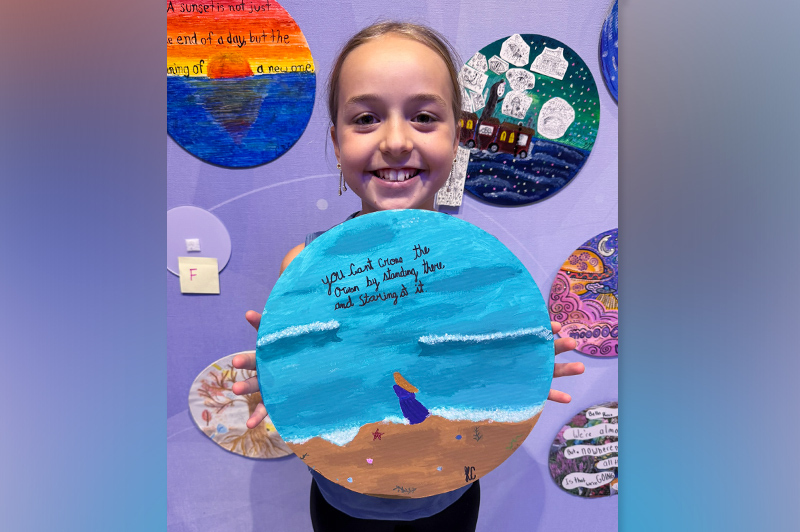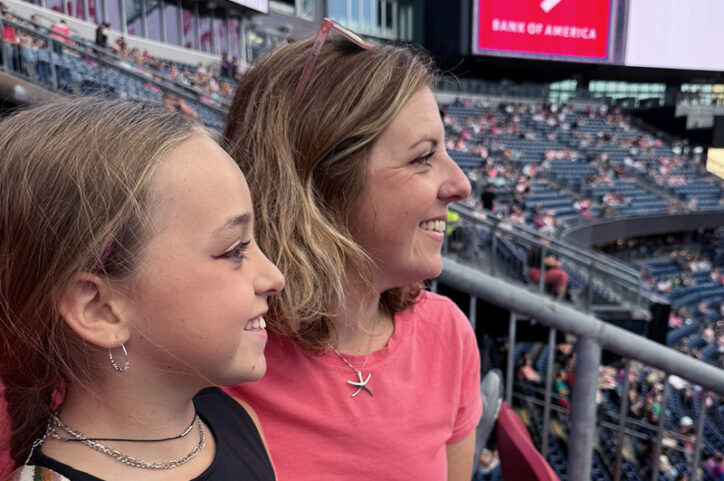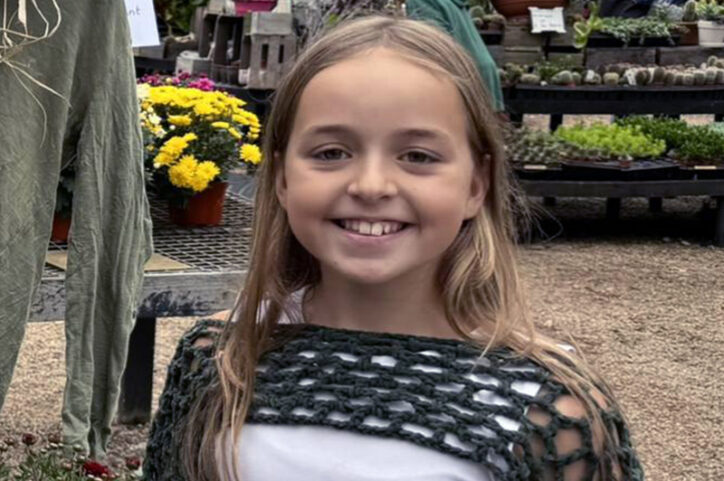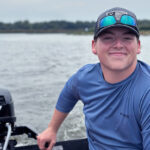Crossing the ocean: Kathryn learns how to manage chronic pain

When Kathryn Chechile, 11, “graduated” from Boston Children’s Pediatric Pain and Rehabilitation Center (PPRC) last year, she painted a tile to hang on the wall of the Center’s space. It’s a fun ritual for patients who complete the intensive day program aimed at helping kids manage chronic pain. Kathryn’s design features a girl looking out at the water with the words, “You can’t cross the ocean by standing there and staring at it.”
The quote is especially meaningful for Kathryn and her mom, Jacki, after their experience in the PPRC. Kathryn, a competitive water skier, was referred to the Center after she developed pain in her foot and ankle.
A diagnosis — and a plan
“At first we thought it was just a sprain,” explains Jacki. But when the pain just got worse over time, Dr. Jeffrey Lo, a physician in the hospital’s Orthopedics and Sports Medicine Department, suspected something else might be responsible: complex regional pain syndrome (CRPS). This condition can cause persistent pain, sensitivity to touch, swelling, and changes in skin color in the affected limb. It appears to be the result the nervous system’s abnormal response to an injury — even a seemingly minor one.
After the team in the Pain Treatment Center confirmed Kathryn’s diagnosis, they suggested she might benefit from the specialized care in the PPRC. This rigorous interdisciplinary program includes regular daily sessions of physical, occupational, recreational or music, and psychological therapy, as well as therapy and support for parents and caregivers. The goal: to help kids transfer the skills they’ve learned back to their home life.
Although the family was initially hesitant about the intensive program — and the two-hour round-trip drive it would involve — they joined the waitlist. But Kathryn’s pain didn’t resolve.
“When they called to tell us they had a space for her, we decided to go for it,” says Jacki. Here, she and Kathryn share some of what they learned during their experience in the PPRC.

Commit to the plan
The Chechiles admit that they viewed the PPRC as “the nuclear option” for Kathryn — the most drastic approach they could imagine taking. So when they decided to join the program, they knew they needed to make the most of it.
“I was clear with Kathryn when we started at the PPRC that we were going to be brutally honest about how things were going,” explains Jacki. “We both knew that would be crucial to success.”
Foster good mental health
During her time with the PPRC, Kathryn learned how much anxiety and sensitivities to noise play a part in her pain. Although she hadn’t enjoyed seeing a therapist in the past, she found the PPRC’s approach more to her liking. Rather than just sitting and talking, Kathryn chatted with psychologist Manuela Villa while they made brownies together and discussed skills and strategies that could become part of her “coping recipe.”
“She made me feel comfortable and really listened,” says Kathryn. “It didn’t feel forced.”
Another perk: weekly visits with Lilly and Maxi, two of the hospital’s Pawprints therapy dogs. “They’re lovely and gave me a great reason to want to be there,” she says. When it came time to graduate, Villa and her colleagues referred the family to InStride, a specialty program to treat pediatric anxiety, to continue Kathryn’s care.

Find your community
When Kathryn was in the PPRC, there were no other kids there her age — but that didn’t stop her from bonding with other patients. “I made a bunch of friends and am still in touch with three of them,” she says. The sense of community also helped her see beyond her own challenges: “When you meet other kids going through the same thing, you realize that you aren’t alone. There’s a community of people out there standing by your side.”
Jacki agrees. “I developed a rapport with the other parents. We were all on the same journey and able to support each other as we went through it.”
Make it work for you
While the PPRC includes plenty of group activities, the Chechiles loved that so much of the program felt personalized to Kathryn. Because she’s a water skier, the team encouraged her to use it as an exercise goal, gradually building her tolerance to that activity.
Together with her recreational therapist, Anne Archer, she created a collage filled with images that represented some of her other goals: skiing, having fun with friends, and attending a concert by singer P!nk for her birthday.
Kathryn also learned to embrace activities she didn’t really enjoy, like deep breathing. Although she’s still not a huge fan, she knows that belly breathing can be helpful for her. “It’s a little like taking out the trash,” she explains. “You might do it willingly, but when someone tells you that you have to do it, you don’t want to do it anymore. When I can do deep breathing on my own without being told, that’s when I want to do it.”

Learning to pivot
Today, about six months out from her PPRC “graduation,” Kathryn says she’s learned some valuable tools to help address pain and anxiety. Aside from belly breathing, she’s learned to crochet and also uses fidget tools to help her focus. Along with water skiing, she’s looking forward to playing basketball this season — an activity she missed last year.
And that P!nk concert? Kathryn and Jacki went and had fun, with a few adjustments, like sitting inside when the noise felt like too much.
“Going into the PPRC, we hoped Kathryn’s pain would magically disappear, but that’s not real life,” says Jacki. “Now, Kathryn knows how to pivot when things aren’t going well and uses the strategies she learned.”
“I still have pain and I still have anxiety,” says Kathryn. “But now I know how to deal with them.”
Learn more about the Pediatric Pain and Rehabilitation Center.
Related Posts :
-

No longer just 'getting through the day': Addressing Lucie's chronic pain
Lucie Robert had always been an engaged and active kid: At just 10 years old, she loved Nordic skiing, dancing, and ...
-

New possibilities: How Caden learned to manage chronic pain — and found an unexpected path
In October 2020, Caden Deutsch started feeling sick. Although the 17-year-old had been coping with juvenile idiopathic arthritis since he was ...
-

‘Worth the trip’: Aiden and his family found help for chronic pain in Boston
Aiden Kozak loves playing volleyball — and he’s good at it. He was even recently named one of the top 50 ...
-

‘It’s worth it’: Dianna finds support in managing her chronic pain
For Dianna Aguiar, 18, playing tennis, practicing yoga, and going for walks with her dog aren’t just fun ways to ...





